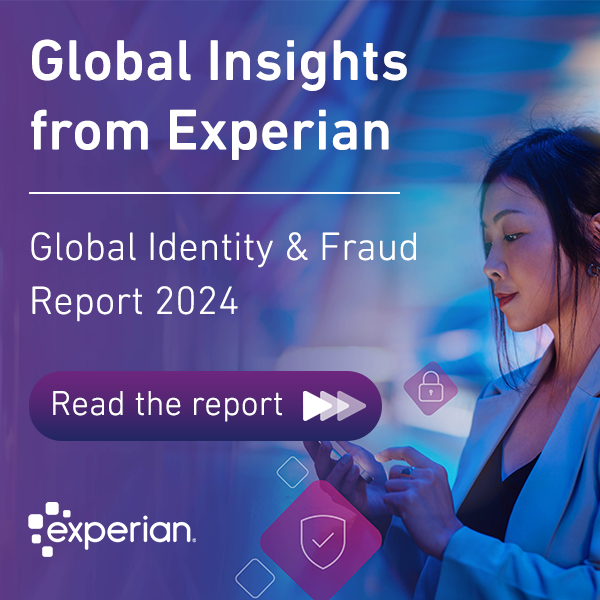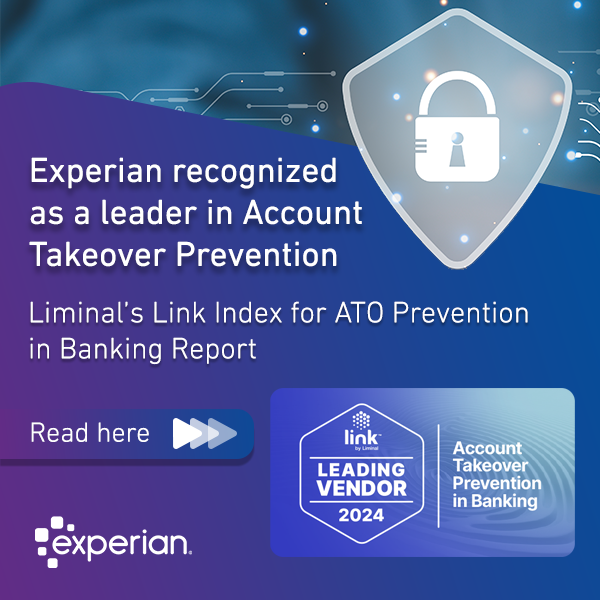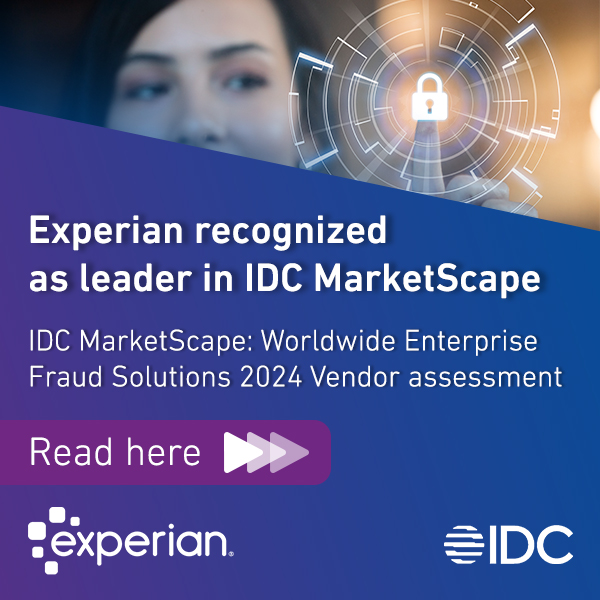Search Results for: data

Did you miss these September business headlines? We’ve compiled the top global news stories that you need to stay in-the-know on the latest hot topics and insights from our experts. Lending in a Two-Lane Economy Harry Singh, Senior VP, Global Decisioning, features on this CU Management podcast, discussing ways in which Credit Unions can best serve their customers with loans and other products within what Experian's latest research refers to as the two-lane economy. The deepfake-scape: How to fight fraud in the digital age This Biometric Update article by David Britton, VP of Industry Solutions, looks at why deepfakes are a big risk to businesses and consumers, and how fighting fire with fire in the form of artificial intelligence and machine learning can be the best form of defence for organizations. Focus on Data, Advanced Analytics and Decisioning Creates a Winning Strategy for Experian Global Banking and Finance announce that Experian has been ranked number 11 in the IDC FinTech Rankings Top 100 which highlights the top 100 global providers of financial technology, with the piece referring to Experian as a “rising star.” The Rise Of Voice Cloning And DeepFakes In The Disinformation Wars Forbes's Jennifer Kite-Powell uncovers that although deepfake fraud is dominant in social media, it is quickly moving into business sectors. Kite-Powell talks to David Britton, VP of Industry Solutions, about what businesses can do to counteract deepfake fraud tactics like voice-cloning. Shri Santhanam talks AI in lending On this Fintech One to One podcast from Lendit FinTech News, Shri Santhanam, Global Head of Advanced Analytics and AI, talks about how lenders in the FinTech space should be using AI and machine learning, and what key trends he has encountered through the years, and what we might expect to see in the future. Stay in the know with our latest insights:

The pandemic accelerated the number of digital interactions in finance. Typical methods of managing finances, connecting with lenders, and buying goods and services were much harder due to lockdown measures, so consumers went digital, including large numbers of non-digital natives. As the demand for online banking and services has intensified – moving from a necessity to a preference for many - pressure on businesses is twofold. They must rapidly build new and better models to onboard customers and create a more dynamic customer journey. In many markets, doing so is the biggest competitive differentiator right now. Creating a dynamic digital journey and understanding the customer With Millennial customers becoming a bigger influence in the space, organizations were always going to have to plan for a slicker and quicker digital customer experience to keep up with expectations. The pandemic simply accelerated this, forcing businesses to rapidly react. In fact, although 9 in 10 businesses have a digital customer journey strategy, 49% of those businesses only put this in place as Covid-19 began according to research in our Global Decisioning Report 2021. This did help them improve in some areas, including access to quicker customer service responses online. But without the right technology in place, it is not surprising that 55% of customers surveyed said they expect more from their digital experiences. Such a rapid shift has exposed weaknesses around agility, leaving traditional institutions trailing Fintech competitors further down the digital transformation road. However, whilst Fintechs have the benefits of agility, traditional, established lenders have large amounts of customer data from which they can target and tailor existing customer journeys more effectively. Improve the digital onboarding process Optimizing the digital experience for new customers from the beginning encourages usage and, ultimately, loyalty. A stress-free and fast onboarding process is an expectation for the younger generation but can also capture the ‘new to digital’ group migrating online. Bio-metric recognition technology, instant document verification, and auto-filling customer data are far more appealing than entering hundreds of data points, and can boost efficiency and reduce friction. The problem is businesses rightly want to make sure they can remove any bad actors to reduce risk and prevent fraud. The key is doing so without disrupting the genuine, low risk customers. Building better models to onboard customers Covid continues to shift population demographics due to factors such as job losses, furlough schemes and migration of workers to alternative sectors. There is also the realization of pent-up demand for property and vehicles, in particular - among those fortunate enough to be less impacted - such as those able to save more as they work from home. This has led to a change in the demand for finance with a need to tailor experiences to specific customer requirements. As the number of credit needs grow, lenders must have a structure in place that allows them to scale and handle the increased volume. New models must also be introduced to allow organizations to access extensive data insights and ensure they are reflecting the ‘new normal’. As businesses move away from sampling towards models that are based on full populations there must be a marriage of technology with data. Data is ultimately captured for the benefit of the lenders, helping them to gauge risk and tackle fraud. But a blended, multi-layered approach in which customers are only asked for the information specific to their individual circumstances – at the appropriate time – can provide a positive and tailored onboarding process. Having solutions in place that combine risk-based authentication, identity proofing, credit risk decisioning and fraud detection into a single platform ensures all checks can be carried out in one place with minimal disruption to the onboarding journey. Putting businesses in first place Online experience and credit and fraud risk management need to be more closely entwined. As the demand for a simple and fast experience intensifies, a digital-first approach that puts businesses ahead of the game must involve embracing the right technology that supports the entire customer journey. Download a copy of the eBook here. Stay in the know with our latest research and insights:

Innovation in fraud detection and prevention is key in today's ever-evolving digital landscape. Juniper Research, a research firm that specializes in identifying and appraising new high growth market sectors, recognized organizations and platforms that drive innovation and growth in the banking, fraud and security, and retail and payments through their Future Digital Awards. The firm awarded Experian as the Platinum Winner for Fraud Detection and Prevention Platform (CrossCore™) and the Gold Winner for the Artificial Intelligence Platform (Ascend Intelligence Services™). Keeping more consumers safe According to this year's Global Identity and Fraud Report, more than half of businesses will continue to invest in fraud prevention solutions over the coming year to combat several types of fraud: new account opening fraud, account takeover fraud, and other types of identity fraud, with at least 57 percent of businesses report higher losses from account opening and account takeover fraud. Identity-related fraud has evolved towards more automation, in the form of scripted attacks and bot attacks, as well as more sophisticated phishing attacks. The speed at which fraudsters adapt to new technology and behavior has always been a problem, and with sudden and unpredictable change, reacting quickly with new fraud strategies has never been more important for businesses looking for ways to safeguard digital transactions. CrossCore™, launched in 2016, is used globally to connect identity and fraud capabilities. The system combines robust risk-based authentication, identity proofing and fraud detection into a single, state-of-the-art cloud platform to make real-time risk decisions throughout the customer lifecycle. Typically, businesses need to move through validation, contract and then integration in order to combat fraud – making for a long, tedious and expensive process. CrossCore pre-qualifies fraud and intelligence services so that businesses can choose how they want their transactions to be processed and which fraud and identity services they want to use. The platform is designed to help businesses instantly identify good customers, catch fraud and enhance the customer experience. Juniper Research’s Future Digital Awards for Fintech & Payments recognized Experian’s CrossCore as the Platinum Winner for the Fraud Detection and Prevention Platform. The recognition comes at a time CrossCore and AIS platforms are helping businesses all over the world combat fraud and maintain a safe digital experience for their customers. This recognition underscores the commitment to using advanced capabilities in data, analytics and technology to bring innovative fraud solutions to the market, enabling businesses outpace fraud while making it safer for consumers to engage with them digitally. Providing better digital service The acceleration to digital has caused financial institutions to quickly evolve and improve their processes including reducing time for loan approvals, access to more financial produce and new innovative payment methods. What is most important is that businesses focus on more on advanced technologies for lending. Launched in January 2021, AIS provides financial institutions and other lenders with AI solutions delivered rapidly and digitally, resulting in better business outcomes at every stage of the customer lifecycle. AIS is a one-stop-shop of building, documenting, deploying, monitoring, and retraining analytics, all on the same AI platform. The system allows businesses to process data with extreme speed and efficiency in a streamlined approach to detect and monitor identity models and strategies. Juniper Research’s Future Digital Awards for FinTech & Payments also recognized Ascend Intelligence Services™ (AIS) as the Gold Winner for the AI Platform. By creating accessible AI solutions for our business clients, people engage with their favorite financial brands in a more meaningful way across the customer lifecycle, truly democratizing advanced analytics. Learn more about Ascend Intelligence Services and CrossCore. Stay in the know with our latest research and insights:

Getting the most out of your AI investment Work backward from impact - give yourself room to experiment Hire the best data talent and partner with the right provider Take a holistic approach - don't just focus on performance AI allows businesses to process sheer volumes of data and multi-tiered models with extreme speed and efficiency. But, scaling AI to meet shifting business demand can be challenging. Experian's Ascend Intelligence Services expertly partners with organizations to build custom, scalable AI and ML solutions to meet those requirements. Listen to Shri Santhanam advise on how to scale AI

Why digital acceleration has created more opportunities for deepfake fraud tactics like voice cloning and what businesses can do about it Digital acceleration has placed information and services in the hands of the masses, connecting individuals on a global level like never-before, and in turn making them increasingly dependent on devices in their daily lives. The argument for technology as an equalizer in society is a strong one. Most people have a voice and a platform, producing millions of virtual interactions and recordings every day. But in this digital world of relative anonymity, it is difficult to know who is really on the other side of the connection. This uncertainty gives fraudsters an opening to threaten both businesses and consumers directly, especially in the realm of deepfakes. What is a deepfake? Deepfakes are artificially created images, video and audio designed to emulate real human characteristics. Deepfakes use a form of artificial intelligence (AI) called deep learning. A deep learning algorithm can teach itself how to solve problems using large sets of data, swapping out voices and faces where they appear in audio and video. This technology can deliver extraordinary outcomes across accessibility, criminal forensics, and entertainment, but it also allows a way in for cybercriminals that hasn’t existed until now. Deepfake fraud tactics A principal tactic among deepfake fraud is voice cloning – the practice of taking sample snippets of recorded speech from a person and then leveraging AI to understand speech patterns from those samples. Based on those learnings, the modeler can then use AI to apply the cloned voice to new contexts, generating speech that was never spoken by the actual voice owner. For businesses, deepfake tactics such as voice cloning means access to points of vulnerability in authentication processes that can put organizations at risk. Fraudsters may successfully bypass biometric systems to access areas that would otherwise be restricted. For government leaders, it can mean the proliferation of misinformation – a growing area of concern with huge repercussions. For consumers, the risk of falling victim to scams involving access to personal information or funds is particularly high when it comes to voice cloning. How to prevent deepfake fraud 1. Vigilance: Stay on top of sensitive personal information that could be targeted. Fraudsters are always at work, relentlessly seeking out opportunities to take advantage of any loophole or weak spot. Pay close attention to suspicious voice messages or calls that may sound like someone familiar yet feel slightly off. In an era of remote work, it is important to question interactions that can impact business vulnerabilities – could it be a phishing or complex social engineering scam? 2. Machine learning and advanced analytics: Deepfake fraud is an emerging threat, which leverages the development and evolution of the technology that fuels it. The flip side is that businesses can in fact use the same technology against the fraudsters, fighting fire with fire by deploying deepfake detection and analysis. 3. Layered fraud prevention strategy: Leveraging machine learning and advanced analytics to fight deepfake fraud can only be effective within a layered strategy of defense, and most importantly, at the first line of defense. Ensuring that the only people accessing the points of vulnerability are genuine means using identification checks such as verification, device ID and intelligence, behavioral analytics, and document verification simultaneously to counter how fraudsters may deploy or distribute deepfakes within the ecosystem. As with many types of fraud, staying one step ahead of the fraudsters is critical. The technology and the tactics continually evolve, which may make the countermeasures on the table right now obsolete, however the fundamentals of sound risk management, with the right layered approach, and a flexible and dynamic solution set, can mitigate these emerging threats. Stay in the know with our latest research and insights:

Fraud threats continue to rise across the globe as consumers are spending record amounts of time online due to the pandemic. At the same time, emerging threats of fraud are growing, as fraudsters are taking advantage of the globally shifting economic conditions. Fraud prevention remains a top concern for both consumers and businesses alike. Anticipating future fraud risk is critical and companies are adopting more complex technology systems to ensure consumers’ financial safety. To provide a safe and convenient experience, businesses need to take a customer-first approach when evaluating the latest technology and solutions available to them. To ensure they are providing secure online experiences, businesses are turning to verification strategies using data technology and other detection methods. In fact, according to this year’s Global Identity and Fraud Report, customer recognition security strategies have become the new norm for businesses with 82 percent of companies saying they now have one in place, a 26 percent increase since the start of the pandemic. An independent research firm headquartered in Germany, KuppingerCole Analysts, released a report, Leadership Compass: Fraud Reduction Intelligence Platforms, that provides an overview of the market segment, vendor service functionality, prevention measures and innovative solutions to fraud. The report cites Experian as an overall leader, product leader, innovation leader, market leader and technology leader in fraud reduction intelligence platforms. Experian is also credited for taking a client-oriented upgrade approach and delivering other cutting-edge features while maintaining compatibility with our older platform releases. We also scored a strong positive for interoperability, usability, deployment, innovativeness, market position, financial strength and ecosystem; and a positive in security and functionality. We pride ourselves in our digital identity protection services and consumer safety, taking proactive approaches to fraud prevention and providing businesses with the necessary tools to identify risks of fraud. The report discusses fraud prevention measures and innovative solutions to fraud. According to the report, cybercrime costs will reach $10.5 trillion by 2025. The report evaluated 15 different data security and fraud prevention platforms and ranked their products, innovation, market positioning and technology in their report. All of Experian’s fraud detection and prevention services are available through our CrossCore® partner ecosystem. By combining advanced analytics, rich data assets, identity insights and fraud prevention capabilities, businesses can connect any new or existing tools and systems in one place, whether it be Experian’s, Experian’s partners or its own. With its built-in strategy design and enhanced workflow, fraud and compliance teams have more control to quickly adjust strategies based on evolving threats and business needs, which helps to improve efficiency and reduce operational costs. Learn more about the CrossCore platform. Stay in the know with our latest research and insights:

A recent industry-leading analyst report looking at loan origination solutions found that lenders are experiencing high volumes of new loan applications, but many are struggling to process them. This alongside increased consumer demand for improved digital experience, and a shifting credit landscape means lenders are trying transform both to keep operating costs down and meet the needs of a changing market. This tracks closely to findings from our Global Decisioning Report 2021. We look at what is changing, and how the Now Tech: Loan Origination Solutions report advises lenders to move forward. Consumers went online, and have high expectations of the digital experience The pandemic shut down banking and retail locations around the world. Amidst the lockdown, consumers turned online to manage finances, connect with lenders, and buy essential goods and services. The crisis especially accelerated digital adoption for older consumers and created a new digital imperative for lenders wanting to meet customers’ evolving needs. The rise of self-service and new payment methods There was also an increase in the already growing demand for digital self-service in terms of applying for credit and seeking out repayment support. Consumers expect to be able to apply for credit when and where they need it, often using a mobile-friendly device. In return for convenience and security, consumers report that they’re more willing to provide additional personal data. Timely, meaningful credit and repayment offers, convenient interactions, and improved communication with lenders make the exchange worth it. The convenience of digital channels is also creating the opportunity for new payment methods, such as subscription models and Buy Now Pay Later (BNPL). Both are occurring across a range of products and services, from cars to clothes to beauty essentials. Our Global Decisioning Report found that 27% of consumers reported purchasing products using BNPL programs. Traditional lenders will need to consider the needs that the emerging BNPL market meets. This includes making purchases easier for consumers by providing increased payment flexibility. APIs, security, integration, and explainable AI According to the Now Tech report, lenders should look for solutions that allow access to data via APIs for credit decisioning, have strong data security and privacy practices, integrate with third-party technology products and services, and leverage explainable AI for underwriting. Allowing lenders to acquire customers digitally is key, and loan origination solutions provide a digital portal that can be accessed across devices and which supports real-time customer input, document uploads, data aggregation and analysis, and digital signatures. Want to read the full 2021 Global Decisioning Report?

Financial institutions have long been dependent on technology for business operations, resulting in a long history of tech additions, upgrades and vendors. Changes made to legacy IT systems can not only impact customers, but in many cases, the economy too. Often these systems feel safe and familiar, so it can be a difficult choice to make a change. However, over the last year the pandemic has highlighted the need for agility within the market. Responding to changing customer needs in an increasingly digital environment is number one priority. What do we mean by legacy tech? The term legacy tech has a lot of negative connotations. It refers to a set of computer systems, software and technologies that can no longer be maintained or easily updated. The system could be out of support or in extended support. Integration becomes a challenge because different technologies have accumulated over the lifespan of the business, and the associated support levers around it are all different. There is also the challenge of finding the skills to maintain these systems – in-house or outsourced from providers. Maintenance costs can be high – security and resilience test costs will add to this, while performance will drop with the increasing need for work-arounds. Upgrades can be complex, expensive or even impossible on legacy systems, generating extra costs. Financial institutions create their own legacy systems when they start integrating various data sets from different sources. It can happen when the business grows to new locations, new lines of product, extended consumer services, while using different tech from different vendors. Cloud as an enabler for business transformation From the moment code is written and deployed, it becomes legacy. Cloud integration allows for daily code releases and automated upgrades meaning that businesses are constantly adjusting and responding to client needs, regulation and strategic changes. They can instead focus on their business model and innovation, staying relevant and up to date. Budget is directed towards improvements and innovation instead of maintaining the legacy tech. It brings an interesting level of agility, with the ability to respond to the market much more quickly and effectively. How cloud can benefit the customer Cloud-based services have allowed banks to revolutionize onboarding processes and timescales. Processes like KYC (Know Your Customer) can be carried out by partners for a fast and efficient experience. Throughout the lifecycle of a customer, banks can leverage third parties for every part of the journey and ultimately improve customer experience. Beyond the onboarding process, the entire customer lifecycle, from originations to collections, can be transformed by removing friction and using AI to create interest, and ML to make decisions for quick results. Experian has partnered with Open Banking Expo TV to produce a series on Cloud-based solutions. Sign up to watch. Related content

Shri Santhanam, EVP and Global Head of Analytics and AI, talks to Ganesh Padmanabhan from Stories in AI about why he hopes the changing world of lending will lead to better financial inclusion. "The whole digital revolution in lending means that financial institutions are scrambling to make the process much more seamless, reduce time for approvals, let consumers have access to different financial products, and have innovative products like buy now pay later. But underneath it all, you have to get more nuanced and more sophisticated about the methodologies that you use for lending. And this is where AI and ML come in." Expect to hear discussions about the future of finance, how to drive impact by leveraging data analytics and AI, frameworks for setting up and institutionalizing an AI center of competence for a large organization, and how to scale data science efforts through hiring, promoting from within, and setting up the right structure and processes to make it happen. "Experian for over 100 years now has leveraged the power of data. We’ve been a very powerful data company. We’ve used that data to improve the lives of consumers and improve how businesses make decisions. Fundamentally, we’ve had a set of pioneers who before Big Data tech was introduced to the world, figured out that having a data marketplace or collecting high quality data on consumer lending will be of value, and that’s been the core of our business. That dynamic is changing. We see a lot of value migrating what we call up the stack. So from purely data to actually the decisions that are made with the data, to products and services in the data." Related content

Did you miss these June business headlines? We’ve compiled the top global news stories that you need to stay in-the-know on the latest hot topics and insights from our experts. Fintech Interview with Executive Vice President, Experian – Eric Haller FinTech Buzz talks to Eric Haller, VP & General Manager, Identity, Fraud & DataLabs, about various key trends and challenges in the Digital Identification domain and how fintech prevents fraud in the financial market. Experian on Fraud: 2020 Was a Big Year for Nefarious Actors and Illicit Activity in Financial Services David Britton, VP, Industry Solutions, Global ID and Fraud at Experian, recently shared with Crowdfund Insider Experian’s insight into fraud and what the business is doing to combat nefarious activity in financial services. Evolution of digital identity Professional Security Magazine Online talks to David Britton, VP of Industry Solutions, about how the preference for digital-first was sparked and then accelerated through the Covid-19 pandemic, but the concept of digital identity and the need for its evolution will remain prevalent for both consumers and businesses way beyond that. Preventing fraud without compromising the customer experience Finextra looks at Experian's Global Identity and Fraud Report 2021 to uncover why customer experience is central to the approach for businesses when balancing fraud prevention and revenue. Three things lenders need to do to navigate today’s complex lending and credit landscape Business Information Industry Association covers Experian's Global Decisioning Report 2021 highlighting the dual-lane economy and what lenders can do to succeed in this complex and changing landscape. Stay in the know with our latest insights:

In a recent interview, I had the opportunity to talk to Chris Preimesberger of eWeek about the latest Global Identity and Fraud Report. We discussed some of the business challenges executives face in the increasingly complex space around fraud mitigation while reflecting on how and why the pandemic has shifted the fraud landscape. Market movement – more of us were online than ever before With so many of us at home during the pandemic, access to digital services and the purchasing of goods online increased dramatically. According to our research, businesses responded by investing in supporting services to accommodate the increase in traffic. We saw a lot of action from businesses around how to improve the customer experience while getting a better understanding of who the customers are and how to get their online problems resolved. Our January research wave showed that with all this investment into customer experience and enablement, there were some key areas of investment. Analytics – the use of automation and AI to help make smoother, better decisions for customers – ranked highly in business priorities, but this approach does not exist in isolation. Businesses are also doubling down on support staff to ensure that consumers have a way, if there’s an anomaly in the process, to be able to respond. Whether that’s password resets or call centre staffing, there’s a desire and there’s an intention by businesses to increase staff on digital support. A shifting sense of recognition We also surveyed consumers on their preference for passwords versus other security methods. Security remains the top consideration for consumers when online, above others such as convenience, but interestingly, for the first time in four years password protection did not appear in the top three preferred security methods, favoring instead a more friction-less approach to authentication. This shift in consumer attitudes towards what we call invisible security paves the way for businesses to start to adopt more sophisticated or nuanced approaches to authentication and security. They can start to leverage behavioral analytics or device intelligence recognition without intruding on the user experience. Normalizing biometrics and the importance of a layered approach Customer attitudes around traditional biometrics are very positive – it’s one of the top-rated preferred security methods thanks to the providers that have popularised it through the mobile devices we all use every day. However, the challenge with pure biometrics is always at the point of enrolment – how do you ensure that the right person is assigning their biometric to a device? This is why a layered approach to security that incorporates traditional identity verification or authentication processes along with more advanced technical elements like behavioral analytics, device intelligence, network access, and transactional context is so important. For example, “Is this device associated with David’s account? Is this actually David or a bot? How does David hold his phone?” This includes layers of security that are considered privacy-safe, and may not even require traditional identity data but have anonymous attributes that can be associated with how someone interacts. This will be pivotal in allowing businesses to enable a more comprehensive, pliable, and flexible approach to security rather than relying on rigid but easily broken mechanisms that we’ve been using for a long time. Why the types of fraud will change as the world seeks normality Over the last year, fraudsters focused their energies on stimulus funding and many other forms of low-hanging fruit that they could easily go after, pulling back from their activities in traditional financial services or e-commerce. As the pandemic eases off in many parts of the world, fraudsters are likely to increase their activity in these areas once again as stimulus programs close down, and as consumers increase their spending. Fortunately, we found that more than half of businesses will continue to invest in fraud prevention solutions over the coming year. Fraud trends to watch in 2021 As we look at the direction in which fraud is moving, we know there is an increase in several types of fraud as we navigate what is becoming the post-pandemic world of 2021. Account takeover fraud is set to be on the rise again this year. This is when stolen credentials are used to gain access to systems. Account origination or new account opening fraud will also be on the increase, where fraudsters use stolen identities to create brand new accounts, including a rise in synthetic identity fraud. Card not present online transactions is something we will see in huge volumes given the explosion of online traffic over the last year, which will undoubtedly include an increased volume of fraudulent transactions. Stay in the know with our latest insights:

Experian has been named a technology leader in Quadrant's 2023 SPARK Matrix: Digital Decisioning Platforms Experian ranked second overall in the latest Juniper Online Payment Fraud Market report, just behind LexisNexis Risk Soultuons and ahead of FICO and TransUnion Experian has been named an Overall Leader by KuppingerCole in its latest Fraud Reduction Intelligence Platform evaluation Ascend Intelligence Services suite of analytics solutions has been named Best Consumer Lending Product in the sixth annual FinTech Breakthrough Awards 2022 Sure Profile wins Platinum for Fraud & Security Innovation of the year at the Future Digital Awards 2021 CrossCore wins Platinum for Fraud Detection & Prevention Platform of the year at the Future Digital Awards 2021 Ascend Intelligence Services wins Gold for AI Platform of the year at the Future Digital Awards 2021 Ranked #11 on the IDC 2021 FinTech Top 100 2021 CIO 100 Awards: Recognized Atlas Credit for their use of the Experian Ascend Intelligence Platform 2021 Winner of the Artificial Intelligence AI Excellence Award 2021 Winner for Best Data Analytics Offering at the Global Retail Banking Innovation Awards 2020 Gold Winner of the Team-Department of the Year category for Decision Analytics at Info Security PG’s Global Excellence Awards 2020 Winner in the ‘Organization’ category for Decision Analytics at Big Innovation Awards Shortlisted for Innovative Product of the Year in 2019 CyberSecurity Awards Named in Forbes 2018 as one of the World’s Most Innovative Companies for 5 Consecutive Years Recognized as an Innovator in the 2017 Fraud Detection and Prevention market Experian CrossCore wins the Javelin Strategy Best Overall Identity Proofing Platform award Top Vendor in the 2017 Online Fraud Detection and Prevention Leaderboard 2017 Gold Winner for Product Management Department/Team of the Year ‘Best Credit Reference & Information Solution’ in 2017 Credit & Collections Technology Awards 2017 Finalist for People’s Choice Award at the MRC Technology Awards 2017 Finalist in the Big Innovation Awards 2017 Winner for Product Innovation in The World Business Awards 2017 Gold Winner for Security Product Management/Development Team of the Year at InfoSecurity Business Awards 2017 Gold Winner for New Products and Services at InfoSecurity Business Awards 2017 Bronze Winner for New Product or Service of the Year Banking CIO Outlook Top 10 Security Solution Providers 2016




